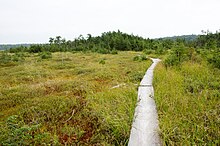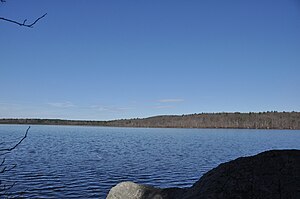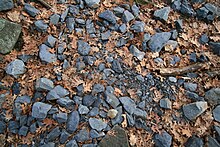Blue Hills reservation
|
Blue Hills reservation
|
||
|
The Ponkapoag Pond with the Great Blue Hill in the background |
||
| location | Norfolk County in Massachusetts (USA) | |
| surface | 28.33 km² | |
| Geographical location | 42 ° 13 ' N , 71 ° 6' W | |
|
|
||
| Setup date | 1893 | |
| Framework plan | Metropolitan Park System of Greater Boston | |
| administration | Massachusetts Dept. of Conservation and Recreation | |
| particularities | Great Blue Hill | |
Blue Hills Reservation is a state park in Norfolk County in the state of Massachusetts in the United States . The park is administered by the Department of Conservation and Recreation and is part of the Metropolitan Park System of Greater Boston . The reserve covers the urban areas of Milton , Quincy , Braintree , Canton , Randolph and Dedham south of Boston .
description
The Blue Hills Reservation (commonly referred to as Blue Hills by local residents ) is primarily used for hiking and mountain bike tours. Downhill and cross-country skiing also take place here in winter , otherwise rock climbing (in designated areas of the park) and equestrian sports are possible in suitable months.
The great variety of landscapes in the reserve, combined with its proximity to the city of Boston, makes it a popular destination for hikers from the Greater Boston metropolitan area . At 194 meters, the highest point in the park is the Great Blue Hill in Milton , on the top of which is the Blue Hill Meteorological Observatory , from which a good view of Boston and the surrounding area is possible.
Depending on the weather, the Blue Hills Ski Area has its own ski area from December to March . In summer, lakes Houghton's Pond and Ponkapoag Pond offer popular and much-used opportunities for swimming and recreation.
The ecology of the protected area is extremely diverse and includes marshland , swamps , forest areas , meadows and a bog with white false cypresses . Some endangered species in Massachusetts , such as the forest rattlesnake , also live in the park. Other examples of the local flora and fauna include dogwood , orchids , coyotes , turkey vulture, and North American copperhead .
The reserve has close ties with the Massachusetts Audubon Society , named after the noted ornithologist John James Audubon . One result of the collaboration is the Trailside Museum , which shows exhibits from the park's animals. The Observatory Blue Hill Meteorological Observatory on the Great Blue Hill was founded in 1885 and is the oldest continually operated weather station in the United States.
Because the area is just a few miles south of downtown Boston , it is the largest contiguous sanctuary within a US metropolitan area .
history
The Blue Hill got its name from the early European explorers, who noticed a bluish glow on the hill, as they sailed along the coast. The blue color comes from the riebeckite that is contained in the stones.
More than 10,000 years before the first Europeans reached the country, Indians had already settled in the hills. They referred to themselves as Massachusett , which translated means as much as people of the great hills . The name of the Commonwealth of Massachusetts has its origin in this Indian name.
In 1893 the Metropolitan Parks Commission bought the area and designated it as one of the first protected areas in the Metropolitan Park System of Greater Boston . Today the area benefits from a wide range of archaeological and historical resources.
No fewer than 13 entries in the National Register of Historic Places tell the stories of the Native Americans, their discoverers , farmers , quarry workers and inventors .
Leisure and recreational activities

Non-motorized boats can be driven in the reserve, and fishing is permitted. There are campsites , hiking trails , bridle paths , rock climbing opportunities and special routes for mountain bikes . The existing sports facilities and picnic areas are also popular . In winter there is the possibility of ice skating and downhill or cross-country skiing .
Entries on the National Register of Historic Places
In the reserve, 13 locations have been entered on the National Register of Historic Places :
- The seat of the park administration
- The parkways of the entire reserve
- The Brookwood Farm with its old barn
- The Chickatawbut Observation Tower
- The Comfort Station on Blue Hill Avenue
- The Eliot Memorial Bridge near the highest point of Great Blue Hill
- The Great Blue Hill Observation Tower near the highest point of Great Blue Hill
- The Great Blue Hill Weather Observatory at the highest point of Great Blue Hill
- The Massachusetts Hornfels-Braintree Slate Quarry quarry and archaeological dig
- The stables of the Metropolitan District Commission
- The Ponkapoag Camp of Appalachian Mountain Club
- The Refreshment Pavilion on Houghton's Pond
Individual evidence
- ↑ Les Tyrala: The Hard Truth: The Geology of the Blue Hills. ( PDF ; 245 kB) (No longer available online.) Archived from the original on September 28, 2011 ; accessed on June 1, 2012 (English). Info: The archive link was inserted automatically and has not yet been checked. Please check the original and archive link according to the instructions and then remove this notice.
Web links
- The Blue Hills Reservation ( February 8, 2011 memento on the Internet Archive ) - Official website
- Great Blue Hill HazeCam - Panoramic images from the observatory
- Blue Hill Observatory - Official website of the Meteorological Observatory
- Blue Hills Trailside Museum - Massachusetts Audubon Society website
- Friends of the Blue Hills - Organization website


